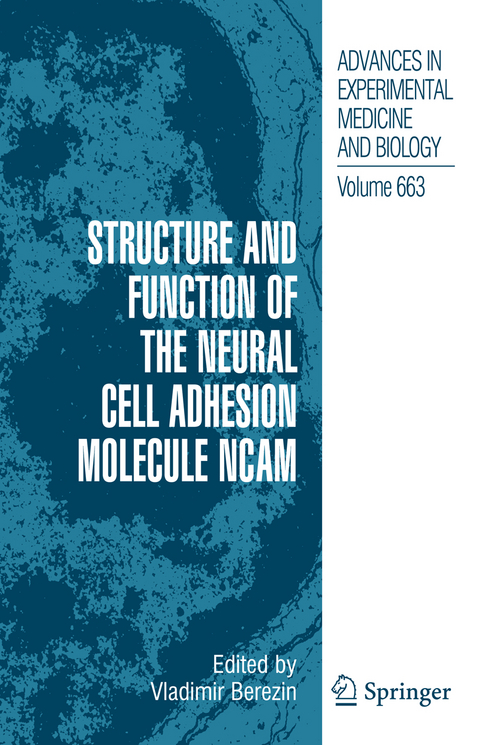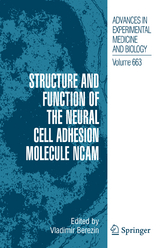Structure and Function of the Neural Cell Adhesion Molecule NCAM
Springer-Verlag New York Inc.
978-1-4419-1169-8 (ISBN)
Dr. Elisabeth Bock (Photo Keenpress) This book contains review articles that produce a snapshot of recent developments in the field of the neural cell adhesion molecule NCAM. The chapters are grouped into sections reflecting various aspects of NCAM structure and function. The themes cover the structural basis of cell adhesion mediated by NCAM and NCAM interaction partners, NCAM-mediated signaling determinants of NCAM function under physiological conditions and in disease, and the therapeutic potential of NCAM mimetics. Section 1, "Structure and Ligands of NCAM," introduces the reader to the str- tural basis of NCAM-mediated cell adhesion, discussing the current knowledge of extracellular and intracellular NCAM ligands and the structural basis of NCAM int- actions with the fibroblast growth factor (FGF) receptor. Section 2, "NCAM and Polysialic Acid," focuses on NCAM polysialylation, discussing the structural and functional aspects of the most important posttranslational modifications of NCAM by the addition of a long linear homopolymer of sialic acid to the fifth Ig-like NCAM module.
Section 3, "NCAM-mediated Signal Transduction," is devoted to signal v BookID 187530_ChapID FM1_Proof# 1 - 01/03/2011 BookID 187530_ChapID FM1_Proof# 1 - 01/03/2011 vi Preface transduction mechanisms associated with NCAM-mediated adhesion, with a focus on signaling pathways involved in NCAM-mediated neurite outgrowth, the role of growth-associated proteins, signaling through lipid microdomains, and signaling crosstalk with the epidermal growth factor (EGF) receptor. Section 4, "NCAM Metabolism," focuses on current knowledge about NCAM biosynthesis and the g- eration and role of soluble NCAM.
Structure and Ligands of NCAM.- Structural Biology of NCAM.- Extracellular Protein Interactions Mediated by the Neural Cell Adhesion Molecule, NCAM: Heterophilic Interactions Between NCAM and Cell Adhesion Molecules, Extracellular Matrix Proteins, and Viruses.- Intracelluar Ligands of NCAM.- NCAM and the FGF-Receptor.- The Role of ATP in the Regulation of NCAM Function.- NCAM and Polysialic Acid.- Polysialylation of NCAM.- Structural Basis for the Polysialylation of the Neural Cell Adhesion Molecule.- The Role of PSA-NCAM in Adult Neurogenesis.- Use of PSA-NCAM in Repair of the Central Nervous System.- NCAM-mediated Signal Transduction.- Signaling Pathways Involved in NCAM-Induced Neurite Outgrowth.- Role of the Growth-Associated Protein GAP-43 in NCAM-Mediated Neurite Outgrowth.- The Neural Cell Adhesion Molecule NCAM and Lipid Rafts.- The Neural Cell Adhesion Molecule and Epidermal Growth Factor Receptor: Signaling Crosstalk.- NCAM Metabolism.- Biosynthesis of NCAM.- Soluble NCAM.- NCAM, Synapses, Emotions, and Memory.- Role of NCAM in Spine Dynamics and Synaptogenesis.- NCAM in Long-Term Potentiation and Learning.- Role of NCAM in Emotion and Learning.- NCAM in Disease.- NCAM in Neuropsychiatric and Neurodegenerative Disorders.- Neural Cell Adhesion Molecule in Cancer: Expression and Mechanisms.- Pharmacology of NCAM: NCAM Mimetics.- NCAM Mimetic Peptides: An Update.- Synthetic NCAM-Derived Ligands of the Fibroblast Growth Factor Receptor.- Dendritic Spine and Synapse Morphological Alterations Induced by a Neural Cell Adhesion Molecule Mimetic.- Orthologs and Paralogs of NCAM.- Fasciclin II: The NCAM Ortholog in Drosophila melanogaster.- The Neural Cell Adhesion Molecule NCAM2/OCAM/RNCAM, a Close Relative to NCAM.- Conclusion.- Honoring Dr. Elisabeth Bock.
| Reihe/Serie | Advances in Experimental Medicine and Biology ; 663 |
|---|---|
| Zusatzinfo | 45 Illustrations, color; 22 Illustrations, black and white; XVI, 434 p. 67 illus., 45 illus. in color. |
| Verlagsort | New York, NY |
| Sprache | englisch |
| Maße | 155 x 235 mm |
| Themenwelt | Medizin / Pharmazie ► Medizinische Fachgebiete ► Neurologie |
| Studium ► 1. Studienabschnitt (Vorklinik) ► Physiologie | |
| Naturwissenschaften ► Biologie ► Humanbiologie | |
| Naturwissenschaften ► Biologie ► Zoologie | |
| ISBN-10 | 1-4419-1169-3 / 1441911693 |
| ISBN-13 | 978-1-4419-1169-8 / 9781441911698 |
| Zustand | Neuware |
| Haben Sie eine Frage zum Produkt? |
aus dem Bereich




